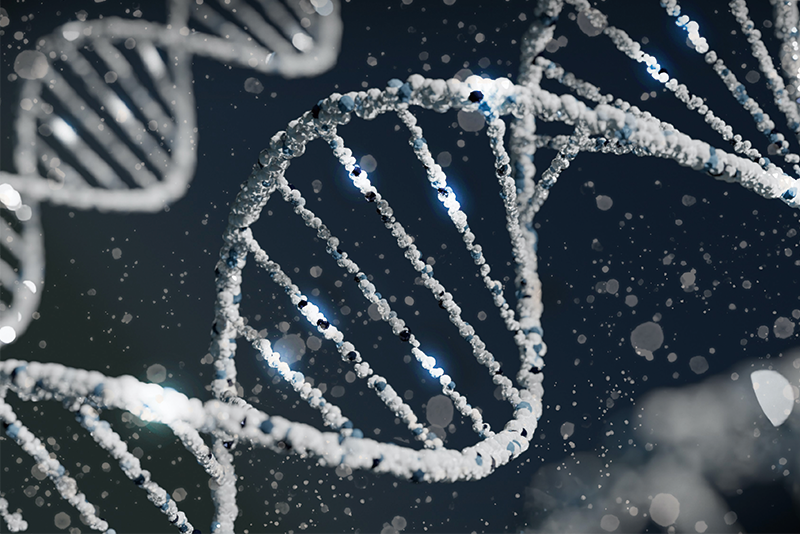Vaccinia Capping Kit
The capping enzyme described possesses three distinct enzymatic activities RNA triphosphatase, guanylyltransferase, and guanine methyltransferase which collaborate to create the Cap 0 structure (m7Gppp5'N) from in vitro transcribed mRNA. In the presence of the vaccinia capping enzyme, along with GTP and SAM as a methyl donor, this intricate process efficiently caps the mRNA within an hour. An essential subsequent step involves the Cap 2' O methyltransferase enzyme, which relies specifically on the Cap 0 structure as a substrate to introduce a methyl group at the 2' O position, ultimately forming the cap-1 structure. This modified cap structure plays a vital role in mRNA stability, translation, and various cellular functions.
Source:
Escherichia coli
Purity:
>95% as determined by SDS-PAGE. Purified by Ni-NTA chromatography.
Unit Definition:
Vaccinia Capping Enzyme
One unit of Vaccinia Capping Enzyme is defined as the amount of enzyme required to incorporate 10 pmols of (α32P) GTP into an 80 nt transcript in 1 hour at 37°C.
mRNA Cap 2'-O-Methyltransferase
One unit is defined as the amount of enzyme required to methylate 10 pmoles of 80 nt long capped RNA transcript in 1 hour at 37°C.
Reaction Condition:
1X Capping enzyme reaction buffer, supplemented with 0.5 mM GTP and 0.2 mM S-adenosylmethione (SAM). Incubate at 37°C.
10X Capping enzyme Reaction Buffer: 500 mM Tris-HCl (pH 8.0), 50 mM KCl, 10 mM MgCl2, 10 mM DTT.
Storage Buffer:
Capping enzymes are supplied in 20 mM Tris-HCl (pH 8.0), 100 mM NaCl, 1 mM DTT, 0.1 mM EDTA, 0.1% Triton® X-100 and 50% Glycerol.
The SAM is prepared in a solution of 0.005 M H2SO4 and 10% ETOH.
Guanosine-5’-triphosphate (GTP) is supplied as a 100 mM aqueous solution at pH 7.5.
Storage:
Stored at -20°C.
For optimal storage, aliquot the reaction buffer, enzymes, and SAM in working concentration into smaller quantities and store at recommended temperature. For most favorable performance, avoid repeated handling and multiple freeze/thaw cycles.
Notes:
Escherichia coli
Purity:
>95% as determined by SDS-PAGE. Purified by Ni-NTA chromatography.
Unit Definition:
Vaccinia Capping Enzyme
One unit of Vaccinia Capping Enzyme is defined as the amount of enzyme required to incorporate 10 pmols of (α32P) GTP into an 80 nt transcript in 1 hour at 37°C.
mRNA Cap 2'-O-Methyltransferase
One unit is defined as the amount of enzyme required to methylate 10 pmoles of 80 nt long capped RNA transcript in 1 hour at 37°C.
Reaction Condition:
1X Capping enzyme reaction buffer, supplemented with 0.5 mM GTP and 0.2 mM S-adenosylmethione (SAM). Incubate at 37°C.
10X Capping enzyme Reaction Buffer: 500 mM Tris-HCl (pH 8.0), 50 mM KCl, 10 mM MgCl2, 10 mM DTT.
Storage Buffer:
Capping enzymes are supplied in 20 mM Tris-HCl (pH 8.0), 100 mM NaCl, 1 mM DTT, 0.1 mM EDTA, 0.1% Triton® X-100 and 50% Glycerol.
The SAM is prepared in a solution of 0.005 M H2SO4 and 10% ETOH.
Guanosine-5’-triphosphate (GTP) is supplied as a 100 mM aqueous solution at pH 7.5.
Storage:
Stored at -20°C.
For optimal storage, aliquot the reaction buffer, enzymes, and SAM in working concentration into smaller quantities and store at recommended temperature. For most favorable performance, avoid repeated handling and multiple freeze/thaw cycles.
Notes:
1. It is recommended to include an RNase inhibitor in your RNA solution to increase its stability. Add 0.5 μL of the RNase inhibitor
(such as murine RNase inhibitor, Croyez #C15049) during the reaction's setup.
(such as murine RNase inhibitor, Croyez #C15049) during the reaction's setup.
2. The reaction should be performed under RNase-free conditions. Use nuclease-free tubes, reagents, and water to avoid RNase
contamination. Also, wear gloves when working with RNA.
Shipping Conditions:
Dry ice
contamination. Also, wear gloves when working with RNA.
Shipping Conditions:
Dry ice
This protocol is formulated to cap up to 10 μg of RNA within a 20 μl reaction.
The reaction size can be adjusted accordingly to accommodate larger quantities, if necessary.
Capping procedures:
1. Combine uncapped RNA and nuclease-free H2O to a final 14 µL.
2. Heating at 65°C for 5 minutes then chill on ice for 5 minutes.
3. Prepare the following reaction mixture on ice and combine it in the specified order:
4. Gently mix the reaction thoroughly to achieve uniform distribution.
5. Incubate at 37°C for 1hrs
(The required incubation time increases as the RNA gets shorter, possibly reaching a maximum of 4 hours. ).
The reaction size can be adjusted accordingly to accommodate larger quantities, if necessary.
Capping procedures:
1. Combine uncapped RNA and nuclease-free H2O to a final 14 µL.
2. Heating at 65°C for 5 minutes then chill on ice for 5 minutes.
3. Prepare the following reaction mixture on ice and combine it in the specified order:
| Component | Amount | Final concentration |
| Denatured uncapped RNA | 14 μL | - |
| 10X Capping Buffer | 2 μL | 1X |
| 10 mM GTP | 1 μL | 0.5 mM |
| 4 mM SAM (dilute 32 mM stock to 4 mM) | 1 μL | 0.2 mM |
| Vaccinia Capping Enzyme | 1 μL | 10 U/ μL |
| mRNA Cap 2'-O-Methyltransferase | 1 μL | 50 U/ μL |
| Total Volume | 20 μL |
5. Incubate at 37°C for 1hrs
(The required incubation time increases as the RNA gets shorter, possibly reaching a maximum of 4 hours. ).
Downloads
→ Essential mRNA FAQs Handbook
KaoTL, Huang YC, Chen YH, Baumann PA, Tseng CK. LARP3, LARP7, and MePCE are involved in the early stage of human telomerase RNA biogenesis. Nat Commun 15, 5955. 2024 Jul 15.


